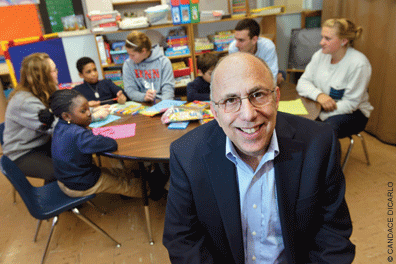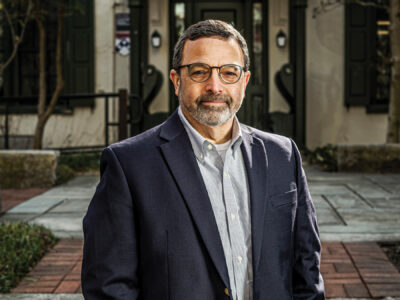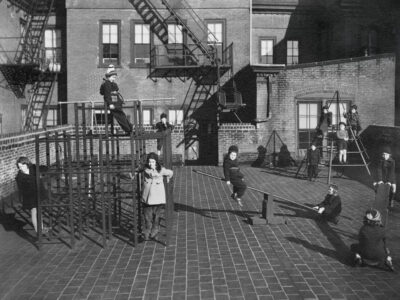This past November, the Netter Center for Community Partnerships celebrated its 20th anniversary with a two-day conference. While 20 years isn’t especially long by Penn standards, there are a couple of reasons this milestone is significant. One is the remarkable impact the center has had on West Philadelphia and Penn’s relationship with that community. The other is its influence on the University itself—and on countless other universities and their neighborhood relationships. When Penn was awarded the 2012 President’s Higher Education Community Service Award for its “commitment to bettering the community through community service and service learning,” the Netter Center’s work was a key reason.
The conference—titled “The Role of Higher Education-Community-School Partnerships in Creating Democratic Communities, Locally, Nationally, and Globally”—featured a keynote address by American Federation of Teachers President Randi Weingarten and a slew of panel discussions. Some 500 faculty members and administrators from 77 universities and more than 100 organizations attended, and many of them showered praise on the center and its founding director, Ira Harkavy C’70 Gr’79. But as Harkavy noted in his opening remarks, the “extraordinary response” to the conference was also a “powerful indicator of how much work remains to be done.”
A week after the conference, Harkavy—whose work with the West Philadelphia community goes back to his student-activist days in the late 1960s and was enhanced by his graduate work with the late Lee Benson, professor of history—spoke with Gazette senior editor Samuel Hughes.
Was this conference and what it represents something you could have envisioned back in, say, 1969?
Not in my wildest fantasies. Even over the years, I don’t think I could have envisioned such a successful conference and extraordinary outpouring of support for the work that Penn and the Netter Center’s been doing. I also could not have envisioned the growth of higher education, the school of community partnerships, and the civic-engagement movement in general.
Historically, universities have always engaged with their environment. But I certainly never thought the breadth and depth of the academic approach, of engaged scholarship, of academically based community service, would be as broad and as deep at Penn.
I didn’t coin this phrase, but I use it shamelessly all the time: “This used to be what Penn does. Now it’s what Penn is.”
How much did your own research into the history of universities and their relationship with their communities help guide the center?
It’s actually been essential to the work we do.
Read Benjamin Franklin’s Proposals Relating to the Education of Youth in Pensilvania—the discussion of learning from real farmers, learning by integration, by doing things. The purpose of learning, the purpose of Penn, the purpose of higher education was to develop “an inclination, join’d with an ability to serve.” Franklin’s approach has been crucial to the work we do.
And John Dewey [about whom Harkavy and co-authors Lee Benson and GSE professor John Puckett wrote in Dewey’s Dream: Universities and Democracies in an Age of Educational Reform] is probably the most seminal figure on the issue of learning by doing critical ongoing reflection, ongoing democratic problem-solving.
“The past is always present in the present”— I don’t know who said that. But the idea that history is alive, and that you need to understand the history of the institution you’re part of, the communities with which you work, and the history of that relationship between the institution and the community, is very important. So is understanding the history of university civic engagement.
The work of the Netter Center, the work that Penn does in this area and nationally, has been crucial for people to understand how engaged scholarship and engagement locally fit into the founding traditions and the ongoing traditions of American higher education—for both the colonial college and the founding of Penn, to the [1862 Morrill] Land Grants, to the founding of Johns Hopkins as the first research university, to the early Penn Wharton School.
Two of the center’s most important components are its academically based community-service (ABCS) courses and its university-assisted community schools. How have the concept and execution of the ABCS courses evolved?
The idea is that they’re not just beneficial to the student, but beneficial to the community and also beneficial to advancing knowledge. And the integration of knowledge, of advancing knowledge and learning and reflection, has evolved over time. We went beyond the very important component of doing critical reflection to learn, to the idea of the integration of service into research as well as learning and the production of knowledge, with the additional strong emphasis from day one of benefit to the community, not just to the university.
Off the top of your head, can you name a few of the most noteworthy ABCS courses?
One is what Walter [Licht, the Annenberg Professor of History] did with the West Philadelphia History Project. A very different approach is occurring with our science, technology, engineering, and math work where Larry Gladney, chair of physics, teaches students. You know, here’s the chair of physics having his students learn physics by teaching at University City High School. That’s profound and powerful.
Bill Labov [professor of linguistics] is one of the greatest sociolinguists in the world. And among his many significant contributions is his work to improve reading among African-American youth, working an ABCS course and volunteering in West Philadelphia with his students. The pioneer of [ABCS courses, emeritus anthropology professor] Frank Johnston, and the work he did in physical anthropology to develop the Agatston Urban Nutrition Initiative, was clearly seminal to our whole development.
The work that [music professor] Carol Muller in ethnomusicology has done around gospel music and Koranic music in West Philadelphia just couldn’t be more different, but it’s powerful. The work that Terri Lipman [the Miriam Stirl Endowed Term Professor of Nutrition] has done in Sayre High School. She has students who are in a nurse-practitioner program working on issues of growth, height, exercise, thriving. Then we can go to the latest work with the Wharton-Netter Center Community Partnership, which is improving even the functioning of our Agatston Urban Nutrition Initiative.
So different individuals have different orientations and work in different fields. And a number of them make extraordinary contributions, and they do it in ways that are appropriate to them, appropriate for their students, and very much appropriate to the community.
What are the biggest challenges for the university-assisted community schools?
The biggest challenge is to do it more and better. Or maybe better and more. Our work has been studied. We have our own full-time evaluator, thanks to the Netter gift. But one of the key issues is that we clearly need to do a better job and engage even more students [and] faculty to substantially improve the conditions of education and community in West Philadelphia and around the country.
Now [through a recent gift from the Netters], we’ve opened regional centers. And other universities are adapting our work. So the work is spreading. But there really needs to be even a stronger, wider network. The idea that higher education has a special partnership for improving communities and schools also needs to be seen as … part and parcel of governmental policy and support.
How hard is it to quantify results?
We do very well—which is one reason we get supported—on performance on multiple grants, usually after-school programs or college access. We just won the AT&T Aspire grant—there were 47 given out of a thousand applicants, and we’re the only one in Pennsylvania—for our college-access programs.
A question that we grapple with is how you really integrate the multiple programmatic studies and impacts into an overall study of the impact of university-assisted community schools. We have a full-time evaluator. We have faculty committees. That’s an ongoing work-in-progress. And you also have to get the information and data from the school district to be able to follow children over time and to really see what your aggregate impacts are.
You also have to have qualitative study of the actual relationships that are going on. It has to look at both the community and the university. It has to engage multiple variables. It has to be done over time. And it has to have as a special component not narrow, short-term indicators, but looking long-term at what the impacts are and then seeing long-term what your actual results are.
You also need to study multiple sites. Penn is one case study. We need to do this around the world.
Anything new on the horizon?
We have a new program this year called the Emerson Fellows for graduates of the University, post-graduate opportunities. One of the students works in Washington with the Coalition for Community Schools; the other student works in West Philadelphia schools focusing on issues of integration of resources, on policy questions, on how to improve our local practice, how to advance the work nationally. So undergraduates or graduate students, mostly undergraduates in this case, have opportunities to carry this work forward after they graduate from Penn.
Another is increasing the model that was developed with the Wharton-Netter Center in 2010, and developing increasing collaboration with all the schools and colleges across Penn. We have faculty arrangements with faculty across the university—from Arts & Sciences, Nursing, Dentistry, other schools. But the formal kind of relationship that we have with Wharton-Netter indicates that we can do more of these school partnerships and combinations. They’re developing with us university-assisted community development. The University is a core economic- and community-development institution, and if its resources can be leveraged and used effectively in purchasing and employment, that’s crucial. They’re the biggest private employer in the city. And engaging the resources of a business school to help expand the economic-development activities in the community—that’s something we want to build on very strongly.
Third, I think, would be interdisciplinary developments and programs that go beyond just multiple courses into even more coherent intellectual approaches: problem-solving opportunities that link a number of courses that do this work, a research project so that undergraduates and graduate students can have an integrated intellectual experience in this regard. We receive funding for a program called the Moorman-Simon Program for Education and Schooling for Democracy and Citizenship. And we are initiating about six faculty seminars that bring faculty together on issues such as health and nutrition, and community-arts partnerships, and STEM [science, technology, engineering, and math] education, and community and the environment, and environmental sciences, and a new one on college access and retention.
We already have groups of faculty who are going to come together, share their work, think [about] how they can develop new courses, and how these courses could be linked—so that a student from Penn could have an integrated intellectual experience on a topic of great substantive interest that involves leading faculty at the University. So the idea of more interdisciplinary activity, but building that activity around both research and teaching and learning and curriculum development—that would really have tremendous impact, both at Penn and the West Philadelphia community.





